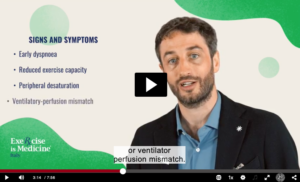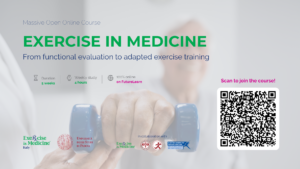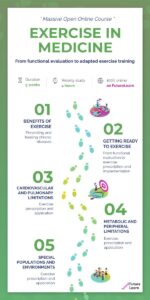Keywords: exercise prescription, cardiopulmonary exercise test, chronic diseases
Although physical activity and exercise are evidence-based treatment modalities for different chronic diseases (class I recommendation, level of evidence A*), the respective implementation in healthcare systems and its impact on public health is still very limited. Indeed, this promising treatment is currently underused in real-world settings, mostly because of a lack of information and awareness. In this blog article we introduce a new Massive Open Online Course (MOOC), which approaches this issue by providing specific interactive and innovative higher education about exercise prescription in chronic diseases and its implementation from clinical settings to the gyms. The MOOC is provided by the Sports and Exercise Medicine Division of the Department of Medicine of the University of Padova, Italy.
Click on the image below to take you to the course homepage.
The physical activity paradox
Physical activity and exercise are highly effective and cost-saving treatment modalities for the prevention and treatment of different chronic diseases (1). Nevertheless, even if there is a lot of scientific evidence and resources demonstrating its huge benefits, there has been a worldwide significant decrease in physical activity levels in recent decades (2).
The World Health Organisation declared thus among its highest priorities to defeat this pandemic of sedentary lifestyle, making people more physically active for a healthier world. The aim is to reduce the global physical inactivity by 10% within 2025 and by 15% within 2030 (3).
The evidence is clear and international guidelines do strongly recommend the “Exercise Pill” for a large variety of health conditions, but is physical exercise really prescribed in the healthcare setting?
Data suggest that there is still work to do (4) and a collective international effort is needed in order that healthcare and exercise professionals have access to this knowledge and can develop abilities to translate into daily practice.
Moreover, cultural initiatives and educational resources are needed for helping clinicians and healthcare professionals in approaching exercise prescription, also by implementing a network among rehabilitation facilities, health-gyms, exercise professionals and the population.
The Massive Open Online Course (MOOC) Exercise in Medicine: From Functional Evaluation to Adapted Exercise Training, actively contributes to this public health issue with an open-access educational resource for a global audience.
Click on the video below to watch!
From clinical evaluations to tailored exercise prescription
Starting from proposing the physical activity level as a routinely evaluated vital sign, the course rationale regarding adapted exercise prescription is based on the individualised assessment of each patient. Among the different functional evaluation methods, cardiopulmonary exercise testing is not only the gold standard to measure cardiorespiratory fitness and efficiency (as some of the most important prognostic markers in medicine), but it also allows to identify underlying functional limitations in the oxygen transport system during exercise. The subsequent exercise prescription should thus try to bypass these functional limitations in order to ensure a safe and effective training program, considering also disease-related risks and comorbidities.
The planning and counselling of the training intervention must start from assessing motivation, identifying barriers to overcome, and implementing exercise as medicine in real-life settings and incorporated in activities of daily living.
Thus, the aim of this course is to learn how to use functional evaluation for adapted exercise prescription and to understand how to integrate exercise as medical treatment into healthcare systems. This interactive MOOC may also facilitate collaboration with colleagues and allied professionals by sharing experiences and best practices, thereby also developing a network within international initiatives working on Exercise in Medicine.
An active learning approach with innovative technologies, many clinical cases and practical insights into exercise prescription/application are provided, while this interactive infographic will give you an overview of the main topics addressed in this course.
Click on the infographic to take you to the interactive version.
Why you should not miss it
This educational project has been actively supported by many high-level international experts in this specific field, providing an added value for this course. Many different clinical conditions and diseases will be addressed, and participants will learn how to bypass the underlying functional limitation with adapted exercise prescriptions for:
- cardiovascular, respiratory, metabolic, neurological diseases;
- patients with cancer, post solid organ transplantation, children and adults with congenital heart disease or other functional disabilities;
- subjects during different stages of life and with mental health disorders.
By the end of the course, participants will be able to:
- Explain the benefits of physical exercise for the prevention and treatment of specific chronic conditions.
- Interpret an evaluation of the patient’s level of physical activity, exercise capacity and cardiorespiratory fitness.
- Describe and articulate an individualised exercise prescription/programme, also addressing patient’s compliance, related barriers, and the environment, from higher altitudes of the mountains to the depth of the seas, considering the impact of ambient temperature as well.
Finally, the MOOC is freely available on the platform FutureLearn!
Here is a sneak peek of some contents!
→ Running out of breath – understanding ventilatory limitations during exercise: In this video, Dr. Daniel Neunhaeuserer explores how to identify ventilatory limitations during functional evaluation and prescribe adapted exercise training with some strategies to bypass dyspnoea (5). Click on the video below to watch and learn about ventilatory limitations!
→ From the clinic to the gym: have a look at the following infographic with the key points to keep in mind while having a successful person-centred conversation regarding an upcoming physical activity intervention (6).

Footnotes:
*Class I recommendations are strong and indicate that the treatment, procedure, or intervention is useful and effective and should be performed or administered for most patients under most circumstances.
References
(1)Pedersen BK, Saltin B. Exercise as medicine – evidence for prescribing exercise as therapy in 26 different chronic diseases. Scand J Med Sci Sports. 2015 Dec;25 Suppl 3:1-72. doi: 10.1111/sms.12581.
(2) Guthold R, Stevens GA, Riley LM, Bull FC. Worldwide trends in insufficient physical activity from 2001 to 2016: a pooled analysis of 358 population-based surveys with 1·9 million participants. Lancet Glob Health. 2018 Oct;6(10):e1077-e1086. doi: 10.1016/S2214-109X(18)30357-7.
(3)Dempsey PC, Friedenreich CM, Leitzmann MF, Buman MP, Lambert E, Willumsen J, Bull F. Global Public Health Guidelines on Physical Activity and Sedentary Behavior for People Living With Chronic Conditions: A Call to Action. J Phys Act Health. 2021 Jan 1;18(1):76-85. doi: 10.1123/jpah.2020-0525.
(4) Foccardi G, Hansen D, Quinto G, Favero C, Coninx K, Ruiz GR, Dendale P, Niebauer J, Ermolao A, Neunhaeuserer D. How do General Practitioners assess physical activity and prescribe exercise in patients with different cardiovascular diseases? An Italian pilot study. Eur J Prev Cardiol. 2021 Jul 10;28(7):e20-e24. doi: 10.1177/2047487320925221.
(5) Neunhäuserer D, Steidle-Kloc E, Weiss G, Kaiser B, Niederseer D, Hartl S, Tschentscher M, Egger A, Schönfelder M, Lamprecht B, Studnicka M, Niebauer J. Supplemental oxygen during high intensity exercise training in nonhypoxemic COPD. Am J Med. 2016 Nov;129(11):1185-1193. doi: 10.1016/j.amjmed.2016.06.023.
(6)Adapted from: Miller W.R. & Rollnick S. “Motivational interviewing: helping people change. Applications of Motivational Interviewing”. 3rd ed. The Guilford Press, New York, 2013.
Author and affiliations
Blog authors and MOOC lead educators:
Daniel Neunhaeuserer MD, PhD*; Giulia Foccardi MD*; Chiara Sarri MSc*; Francesca Battista MD, PhD*.
Working group (MOOC):
Veronica Baioccato MD*; Anna Centanini MD*; Federica Duregon MSc*; Andrea Ermolao MD*; Sara Faggian MSc*; Sara Ortolan MD*; Giulia Quinto MD*; Marco Vecchiato MD*.
Contributing international experts (MOOC):
Paolo Emilio Adami; Gerardo Bosco; Davide Brotto; Ștefan-Sebastian Busnatu; Martina Celidoni; Silvia Cerea; Véronique Cornelissen; Rebecca Gould; Dominique Hansen; Alberto Maran; Tatiana Moro; Marco Narici; Robert Newton; Josef Niebauer; Jean Michel Oppert; Mark Stoutenberg; Willem Van Mechelen; Maurizio Varnier; Nicola Vitturi; Johannes Zwerver.
* Sports and Exercise Medicine Division, Department of Medicine, University of Padova, Italy.


